Events and Festivals as Strategic Tools for Understanding and Assessing the Symbolic Reconfiguration of the World Urban System
Abstract
1. Introduction
2. Urban Events, Symbolic Power, and New Geographies of Cultural Globalisation
3. Methodology
4. Results
4.1. Geographical Transformations in the Global Urban Hierarchy of Events (2017–2024)
4.2. SIEF vs. GaWC: Divergences and Convergences in the Global Functionality of Cities
- (a)
- Cluster 1: Multifunctional global cities
- (b)
- Cluster 2: Regional powers with symbolic aspirations
- (c)
- Cluster 3: Cities specialised in events
- (d)
- Additional insights
4.3. Interrelations Among Major Categories of Urban Events: A Cross-Sectional Perspective
- (a)
- Convergence among major sporting events
- (b)
- Synergies among culture, music, and exhibitions
- (c)
- The transversal role of conferences and conventions
- (d)
- Award ceremonies: an isolated pattern
4.4. Thematic Specialisation and Cultural Convergences: Sport and Music in the Global Urban Network
4.4.1. Sporting Events: Regional and Functional Convergences
4.4.2. Musical Genres: Stylistic Convergences and Shared Audiences
5. Discussion
6. Conclusions
Funding
Institutional Review Board Statement
Informed Consent Statement
Data Availability Statement
Acknowledgments
Conflicts of Interest
Appendix A
| Event Modalities (Weights in %) | Indicator | Source | Units |
|---|---|---|---|
| Mega-events (30%) | Olympic Games | Official website: olympics.com | Host cities for Summer and Winter Olympic Games since World War II; candidate cities since 1945 |
| Universal Expositions | Bureau of International Expositions (BIE) | Number of editions since World War II | |
| FIFA World Cup | Official website: fifa.com | Host cities for Men’s and Women’s FIFA World Cup finals since 1945 | |
| Music Concerts (20%) | Pop music | Official websites of the artists | World tours of Taylor Swift (2023–2024) and Coldplay (2023) |
| Rock music | Official websites of the artists | World tours of Bruce Springsteen (2023–2024) and Guns N’ Roses (2016–2019) | |
| Hip hop | Official websites of the artists | World tours of Kanye West (2013) and Eminem (2014) | |
| Electronic music | Official websites of the artists | World tours of David Guetta (2016) and Lady Gaga (2018) | |
| Opera | Official websites of the artists | World tours of Piotr Beczala (2023–2024) and Aigul Akhmetshina (2023–2024) | |
| Rhythm & Blues | Official websites of the artists | World tours of Beyoncé (2023) and SZA (2023) | |
| Indie music | Official websites of the artists | World tours of Arctic Monkeys (2022) and The Strokes (2020) | |
| Latin music | Official websites of the artists | World tours of Bad Bunny (2022) and Karol G (2023) | |
| Other Sporting Events (20%) | UEFA Champions League | Official website | Host cities of the final since 2010 |
| Copa Libertadores | Official website | Host cities of the final since 2010 | |
| AFC Champions League | Official website | Host cities of the final since 2010 | |
| ATP Tour | Official website | Tournament venues (including Grand Slams and Masters 1000, 500, and 250 series) | |
| Badminton World Championships | Official website | Tournament venues since 2010 | |
| Baseball World Cup | Official website | Tournament venues since 2010 | |
| Formula 1 | Official website | Number of circuits in the 2024 season | |
| American Football | Official website | Super Bowl host cities since 2010 | |
| Basketball World Cup | Official website | Tournament venues since 2010 | |
| NBA Finals | Official website | Host cities since 2010 | |
| Handball World Championship | Official website | Tournament venues since 2010 | |
| Cycling World Championship | Official website | Tournament venues since 2010 | |
| Tour de France | Official website | Final-stage host city since 2010 | |
| Giro d’Italia | Official website | Final-stage host city since 2010 | |
| Vuelta a España | Official website | Final-stage host city since 2010 | |
| Athletics World Championships | Official website | Tournament venues since 2010 | |
| Film Festivals (10%) | Class “A” International Film Festivals | Film Festival World, FIAPF | Number of accredited venues |
| Specialised Film Festivals | Film Festival World | Number of thematic and regional festivals | |
| Art and Cultural Exhibitions (5%) | Art exhibitions | The Art Newspaper (2022–2023); Papercity Magazine (2023) | Most visited museums (2022) and top-rated exhibitions (2023) |
| International Conferences and Congresses (5%) | Conferences | International Congress and Convention Association (2018, 2023) | Number of conferences held (2022) and number of attendees (2018) |
| Award Ceremonies (10%) | Cultural awards | Sandberg (2023); Report (2017) | Host cities of major award ceremonies (since 2010): Nobel, Oscars, Palme d’Or, Pulitzer, Golden Globes, Grammy Awards, Latin Grammys, Tony Awards, Ballon d’Or, and Emmy Awards |
Appendix B
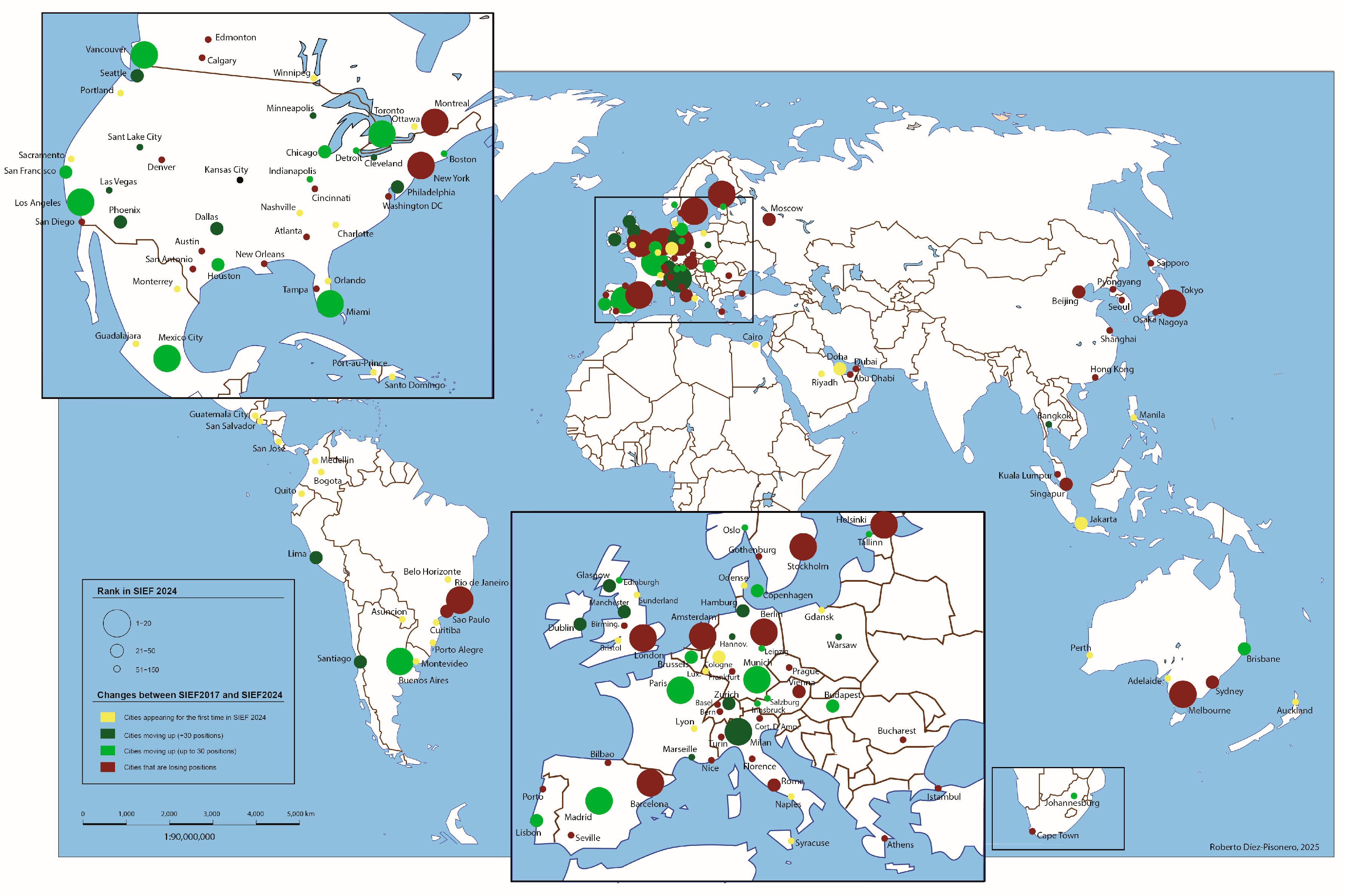
References
- Sassen, S. The Global City: New York, London, Tokyo, 2nd ed.; Princeton University Press: Princeton, NJ, USA, 2001. [Google Scholar]
- Castells, M. La sociedad red: Una visión global. Enl@ce Rev. Venez. Inf. Tecnol. Conoc. 2010, 7, 139–141. [Google Scholar]
- Ritzer, G. La globalización de la Nada; Ediciones Popular: Madrid, Spain, 2006. [Google Scholar]
- Bauman, Z. Vida de Consumo; Fondo de Cultura Económica: Buenos Aires, Argentina, 2007. [Google Scholar]
- Florida, R. The Rise of the Creative Class: And How It’s Transforming Work, Leisure, Community, and Everyday Life; Basic Books: New York, NY, USA, 2002. [Google Scholar]
- Scott, A.J. Social Economy of the Metropolis: Cognitive-Cultural Capitalism and the Global Resurgence of Cities; Oxford University Press: Oxford, UK, 2008. [Google Scholar]
- Richards, G.; Palmer, R. Eventful Cities: Cultural Management and Urban Revitalisation; Butterworth-Heinemann: Oxford, UK, 2010. [Google Scholar]
- Pereira, L.; Jerónimo, C.; Sempiterno, M.; Lopes da Costa, R.; Dias, Á.; António, N. Events and festivals contribution for local sustainability. Sustainability 2021, 13, 1520. [Google Scholar] [CrossRef]
- Peck, J. Austerity urbanism: American cities under extreme economy. City 2012, 16, 626–655. [Google Scholar] [CrossRef]
- Marcuse, P.; Van Kempen, R. Globalizing Cities: A New Spatial Order; Wiley: New York, NY, USA, 2000. [Google Scholar]
- Amin, A.; Thrift, N. Cultural-economy and cities. Prog. Hum. Geogr. 2007, 31, 143–161. [Google Scholar] [CrossRef]
- Harvey, D. The Condition of Postmodernity: An Enquiry into the Origins of Cultural Change; Blackwell: Oxford, UK, 1989. [Google Scholar]
- Zukin, S. The Cultures of Cities; Blackwell: Oxford, UK, 1995. [Google Scholar]
- Díez-Pisonero, R. Los megaeventos: Indicadores del archipiélago urbano mundial desde una perspectiva cultural basada en el consumo de eventos de ocio. EURE 2017, 43, 197–228. [Google Scholar] [CrossRef]
- Taylor, P.J. World City Network: A Global Urban Analysis; Routledge: London, UK, 2004. [Google Scholar]
- Scott, A.J. Beyond the creative city: Cognitive–cultural capitalism and the new urbanism. Reg. Stud. 2014, 48, 565–578. [Google Scholar] [CrossRef]
- De Frantz, M. Culture-led urban regeneration: The discursive politics of institutional change. In The Routledge Companion to Urban Regeneration; Leary, M.E., McCarthy, J., Eds.; Routledge: London, UK, 2013; pp. 526–535. [Google Scholar]
- Richards, G. Culture and tourism: Natural partners or reluctant bedfellows? A perspective paper. Tour. Rev. 2020, 75, 232–234. [Google Scholar] [CrossRef]
- Torres, M.; González, Y.; Manzano, O. Marca ciudad como estrategia de competitividad urbana en las ciudades intermedias. Rev. Espacios 2020, 41, 15. Available online: https://www.revistaespacios.com/a20v41n36/a20v41n36p15.pdf (accessed on 10 February 2025).
- Landry, C. The Creative City: A Toolkit for Urban Innovators; Earthscan: London, UK, 2000. [Google Scholar]
- Scott, A.J.; Storper, M. The nature of cities: The scope and limits of urban theory. Int. J. Urban Reg. Res. 2015, 39, 1–15. [Google Scholar] [CrossRef]
- Getz, D. Event tourism: Definition, evolution, and research. Tour. Manag. 2008, 29, 403–428. [Google Scholar] [CrossRef]
- Richards, G. Cultural Tourism: Global and Local Perspectives; Psychology Press: London, UK, 2007. [Google Scholar]
- Stevens, Q. The Ludic City: Exploring the Potential of Public Spaces; Routledge: London, UK, 2007. [Google Scholar]
- Clark, T.N. The City as an Entertainment Machine; Elsevier: Oxford, UK, 2004. [Google Scholar]
- Hannigan, J. Fantasy City: Pleasure and Profit in the Postmodern Metropolis; Routledge: London, UK, 1998. [Google Scholar]
- Pine, B.J.; Gilmore, J.H. The Experience Economy: Work is Theatre & Every Business a Stage; Harvard Business School Press: Boston, MA, USA, 1999. [Google Scholar]
- Zukin, S. Naked City: The Death and Life of Authentic Urban Places; Oxford University Press: New York, NY, USA, 2010. [Google Scholar]
- Qu, M.; Cheer, J.M. Community art festivals and sustainable rural revitalisation. In Events and Sustainability; Walters, L., Picard, D., Eds.; Routledge: London, UK, 2022; pp. 18–37. [Google Scholar]
- Qu, M.; Zollet, S. Rural art festivals and creative social entrepreneurship. Event Manag. 2023, 27, 1219–1235. [Google Scholar] [CrossRef]
- Getz, D. Festival and event tourism. In Encyclopedia of Tourism, 2nd ed.; Jafari, J., Xiao, H., Eds.; Springer Nature Switzerland: Cham, Switzerland, 2025; pp. 391–395. [Google Scholar]
- Tressera, J. La tematización de las ciudades: El uso de la cultura en las estrategias de desarrollo local y la promoción del turismo urbano. Tur. Soc. 2004, 3, 71–85. Available online: http://revistas.uexternado.edu.co/index.php/tursoc/article/view/2226 (accessed on 4 February 2024).
- Liu, Y.; Chen, C. The effects of festivals and special events on city image design. Front. Archit. Civ. Eng. China 2007, 1, 255–259. [Google Scholar] [CrossRef]
- Essex, S.; Chalkley, B. Urban Transformation from Hosting the Olympic Games; Centre d’Estudis Olímpics (UAB): Barcelona, Spain, 2010. [Google Scholar]
- Shin, N.; Peachey, J.W. Understanding the global–local nexus in the context of the Olympic Games: Implications for managing community development through sport events. J. Sport Manag. 2021, 36, 82–95. [Google Scholar] [CrossRef]
- Novy, J.; Colomb, C. (Eds.) Protest and Resistance in the Tourist City; Routledge: London, UK, 2017. [Google Scholar]
- Gaffney, C. Mega-events and socio-spatial dynamics in Rio de Janeiro, 1919–2016. J. Lat. Am. Geogr. 2010, 9, 7–29. [Google Scholar] [CrossRef]
- Matheson, V.A.; Baade, R.A. Mega-sporting events in developing nations: Playing the way to prosperity? S. Afr. J. Econ. 2004, 72, 1085–1096. [Google Scholar] [CrossRef]
- OECD. Culture and Local Development: Maximising the Impact; OECD Publishing: Paris, France, 2022. [Google Scholar] [CrossRef]
- Quinn, B.; Colombo, A.; Lindström, K.; McGillivray, D.; Smith, A. Festivals, public space and cultural inclusion: Public policy insights. J. Sustain. Tour. 2021, 29, 1875–1893. [Google Scholar] [CrossRef]
- UCLG. 2021 Annual Report of the Committee on Social Inclusion, Participatory Democracy and Human Rights. Annual Report. 2021. Available online: https://www.uclg-cisdp.org/sites/default/files/documents/files/2021-12/EN%20Annual%20report%202021.pdf (accessed on 4 February 2025).
- OECD. OECD Regions and Cities at a Glance 2022. Annual Report. 2022. Available online: https://www.oecd.org/content/dam/oecd/en/publications/reports/2022/11/oecd-regions-and-cities-at-a-glance-2022_7eaf8b80/14108660-en.pdf (accessed on 4 February 2025).
- Sandberg, E. International Prize Culture and Transnational Adaption. In The Routledge Companion to Global Literary Adaptation in the Twenty-First Century; Chua, B., Ho, E., Eds.; Routledge: London, UK, 2023; pp. 217–230. [Google Scholar]
- Zarzosa, P.; Somarriba, N. An assessment of social welfare in Spain: Territorial analysis using a synthetic welfare indicator. Soc. Indic. Res. 2013, 111, 1–23. [Google Scholar] [CrossRef]
- Carradore, M. Social capital in the Italian regions at the time of the COVID-19 pandemic: A comparison of different composite indicators. Int. Rev. Sociol. 2025, 1–18. [Google Scholar] [CrossRef]
- Taylor, P.J.; Derudder, B. World City Network: A Global Urban Analysis, 2nd ed.; Routledge: London, UK, 2016. [Google Scholar]
- Kolotouchkina, O.; Seisdedos, G. The urban cultural appeal matrix: Identifying key elements of the cultural city brand profile using the example of Madrid. Place Brand. Public Dipl. 2016, 12, 59–67. [Google Scholar] [CrossRef]
- Magno, F.; Dossena, G. Pride of being part of a host community? Medium-term effects of mega-events on citizen quality of life: The case of the World Expo 2015 in Milan. J. Destin. Mark. Manag. 2020, 15, 100410. [Google Scholar] [CrossRef]
- Nunes, P. Cities regulated by cultural events: Tracking music festivals in Lisbon and São Paulo. Int. J. Sociol. Leis. 2019, 2, 147–162. [Google Scholar] [CrossRef]
- Novais, M.A.; Humpe, A.; Le, T.H.; Arcodia, C.; Berchtenbreiter, R. Authenticity and visitor motivations: Segmenting visits at the Munich Oktoberfest. Event Manag. 2024, 28, 843–861. [Google Scholar] [CrossRef]
- Rossini, F.; Nervino, E. City branding and public space: An empirical analysis of Dolce & Gabbana’s Alta Moda event in Naples. J. Public Space 2019, 4, 61–82. [Google Scholar] [CrossRef]
- Crofts, C. Bristol fashion: Reclaiming Cary Grant for Bristol—Film heritage, screen tourism and curating the Cary Comes Home Festival. Open Screens 2021, 4, 1–21. [Google Scholar] [CrossRef]
- Li, T. Modeling the local geography of country music concerts in US urban areas: Insights from big data analysis of live music events. Urban Inform. 2023, 2, 4. [Google Scholar] [CrossRef]
- Sirkis, G.; Regalado-Pezúa, O.; Carvache-Franco, O.; Carvache-Franco, W. The determining factors of attractiveness in urban tourism: A study in Mexico City, Buenos Aires, Bogota, and Lima. Sustainability 2022, 14, 6900. [Google Scholar] [CrossRef]
- Cudny, W. Place event marketing in the Asia Pacific region. In Branding and Promotion in Cities; Routledge: London, UK, 2021. [Google Scholar]
- Hutte, G.J.; Markwell, K.; Wilson, E. Celebratory and sustainable? A website examination of the sustainability practices of Australian festivals. Event Manag. 2022, 26, 1315–1333. [Google Scholar] [CrossRef]
- Klingmann, A. Branding Saudi Arabia’s capital: How Riyadh uses urban place marketing, mega-events, and urban destinations as tools to brand the city in line with Vision 2030. Int. J. Ekistics New Habitat 2021, 81, 39–51. [Google Scholar] [CrossRef]
- Snowball, J.D.; Antrobus, G.G. Festival value in multicultural contexts: City festivals in South Africa. Tour. Econ. 2021, 27, 1256–1275. [Google Scholar] [CrossRef]
- UNESCO. Culture 2030 Indicators; UNESCO Publishing: Paris, France, 2022. [Google Scholar]
- Duarte, F.; Ultramari, C. Inflexiones Urbanas y Ciudades Globales: Evidencias y Jerarquías. Biblio 3w Rev. Bibliográfica Geogr. Cienc. Soc. 2007, 12. Available online: http://www.ub.edu/geocrit/b3w-743.htm (accessed on 4 February 2024).
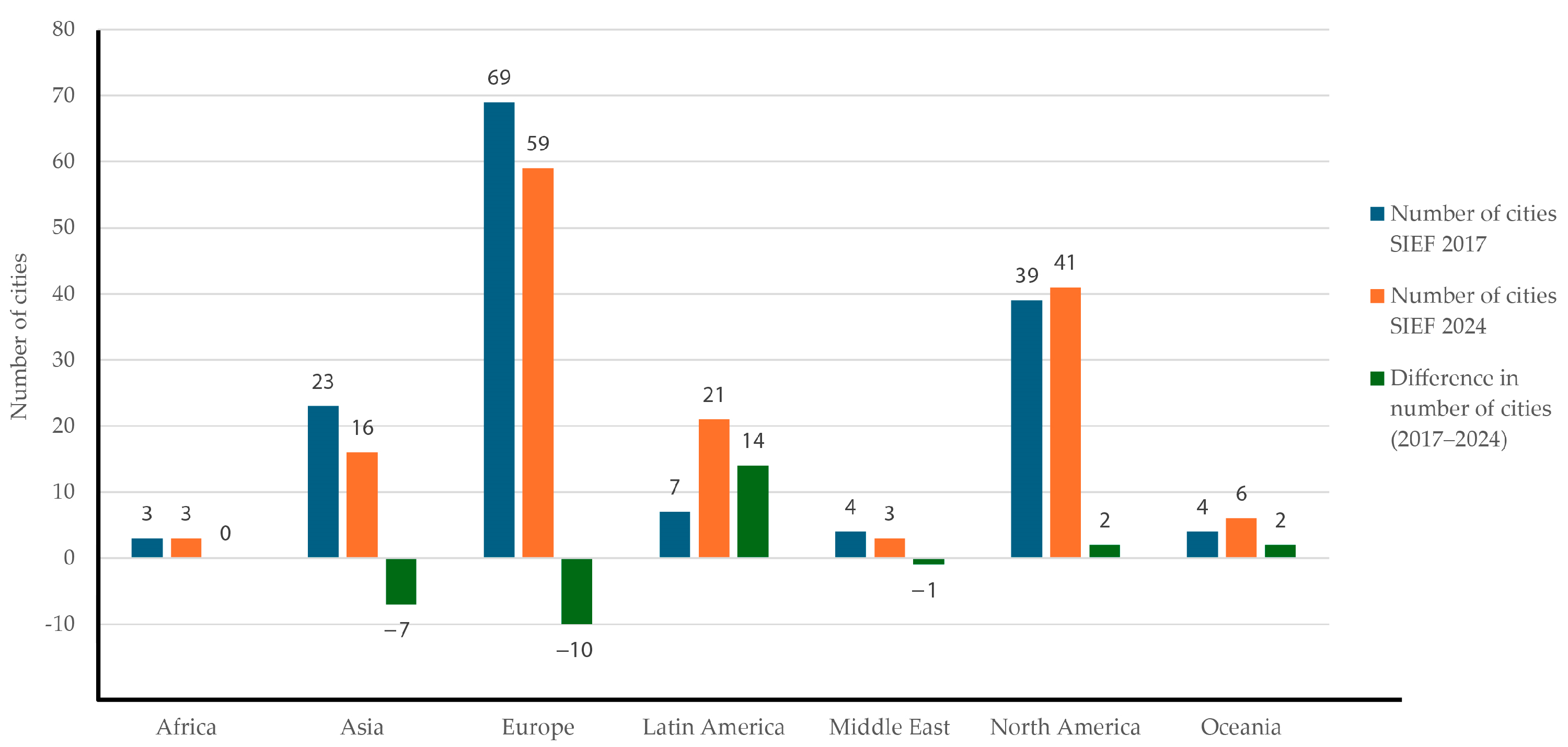
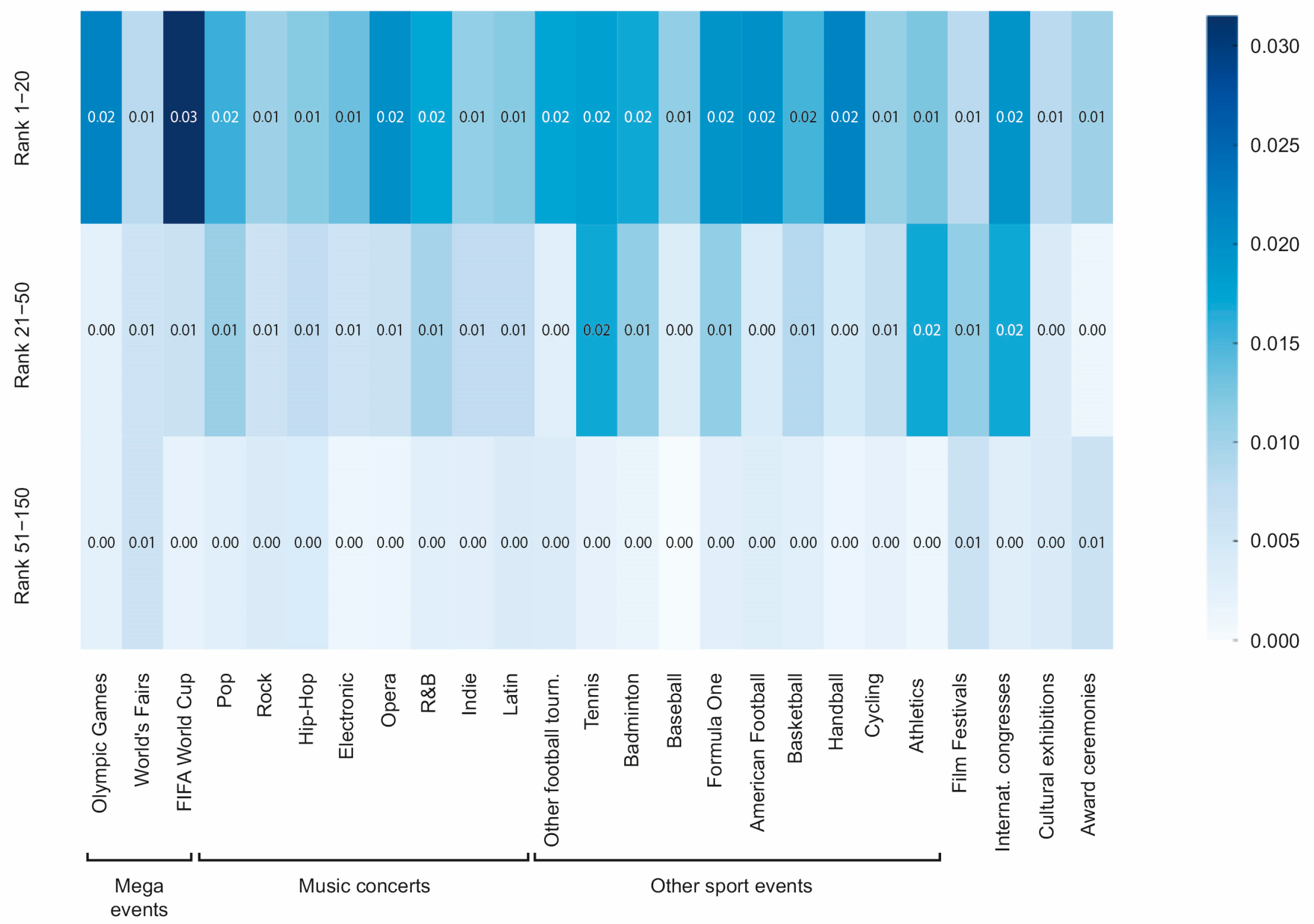


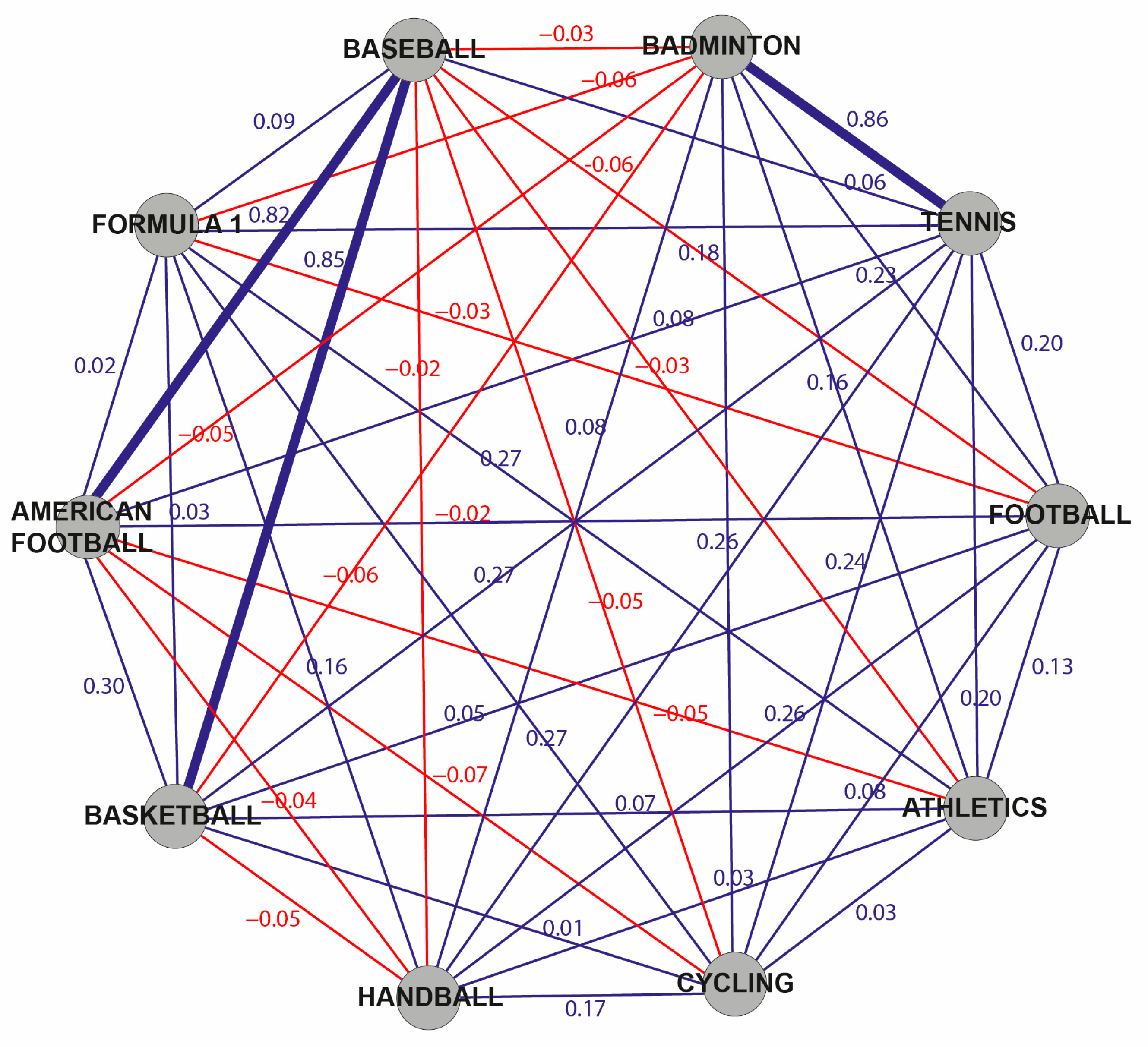
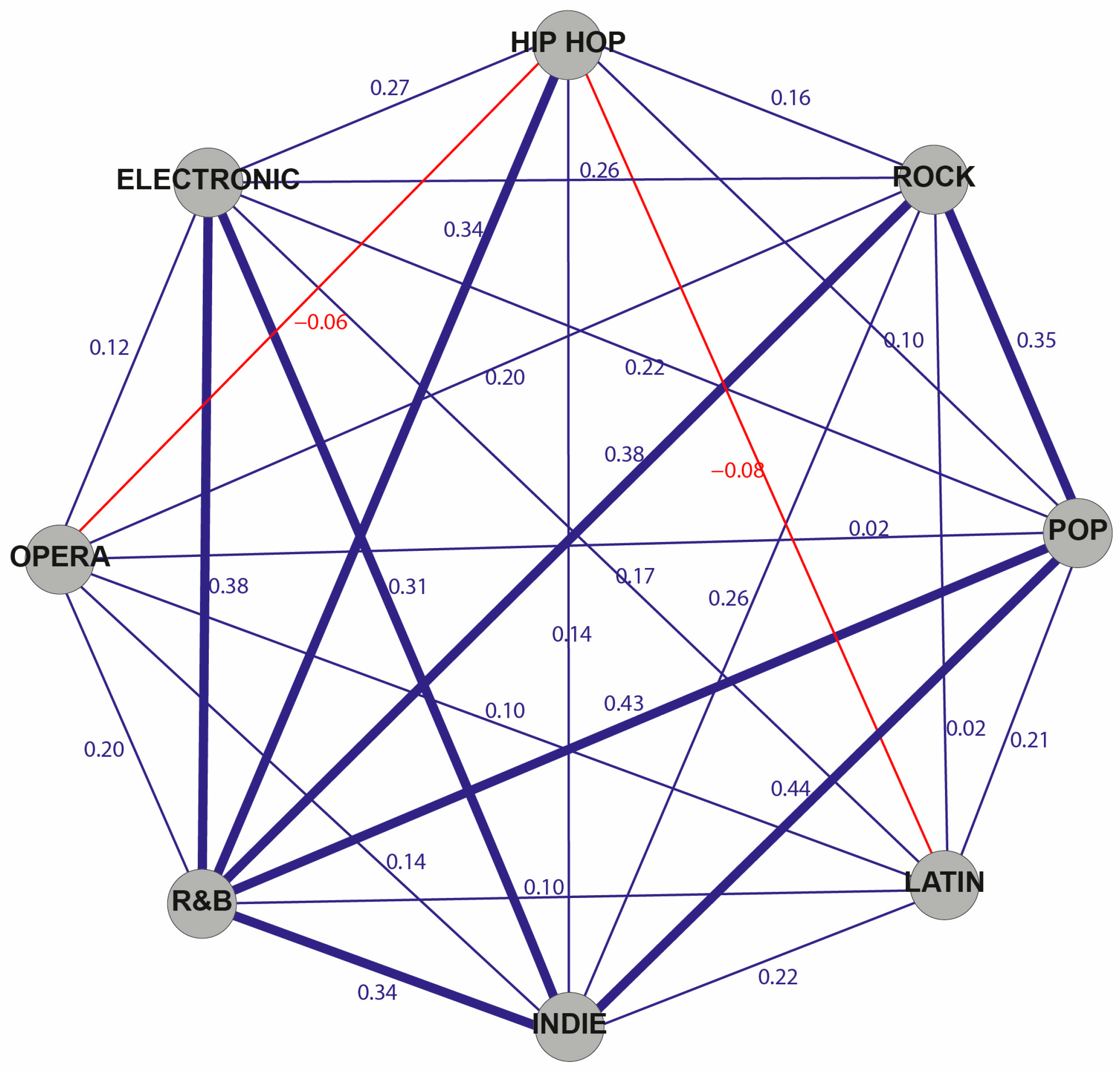
| SIGNIFICANT IMPROVEMENTS | Category | Cities | SIEF 2017 | SIEF 2024 | Change in Rank (2017–2024) | SIGNIFICANT DECLINES | Category | Cities | SIEF 2017 | SIEF 2024 | Change in Rank (2017–2024) |
| Cities not listed in the 2017 ranking now appearing in the Top 50 | Cologne | 151 | 30 | +121 | Cities in the Top 15 in 2017 that have dropped in rank | Berlin | 4 | 19 | −15 | ||
| Doha | 151 | 32 | +119 | Rome | 10 | 23 | −13 | ||||
| Jakarta | 151 | 50 | +101 | Melbourne | 12 | 18 | −6 | ||||
| Cities previously relegated in 2017 now within the Top 50 | Lima | 141 | 49 | +92 | São Paulo | 16 | 22 | −6 | |||
| Manchester | 122 | 40 | +82 | Stockholm | 15 | 20 | −5 | ||||
| Phoenix | 112 | 45 | +67 | New York | 3 | 8 | −5 | ||||
| Dallas | 90 | 26 | +64 | Montreal | 9 | 11 | −2 | ||||
| Dublin | 95 | 43 | +52 | Rio de Janeiro | 13 | 15 | −2 | ||||
| Philadelphia | 93 | 41 | +52 | Tokyo | 7 | 9 | −2 | ||||
| Glasgow | 96 | 44 | +52 | Amsterdam | 6 | 10 | −4 | ||||
| Zurich | 69 | 25 | +44 | Barcelona | 8 | 12 | −4 | ||||
| Hamburg | 63 | 34 | +29 | Cities that have left the Top 25 | Bern | 11 | 144 | −133 | |||
| Santiago de Chile | 52 | 28 | +24 | Shanghai | 25 | 58 | −33 | ||||
| Seattle | 65 | 42 | +23 | Nice | 21 | 72 | −51 | ||||
| Cities entering the Top 20 | Milan | 36 | 5 | +31 | Vienna | 14 | 38 | −24 | |||
| Mexico City | 27 | 7 | +20 | Helsinki | 24 | 46 | −22 | ||||
| Buenos Aires | 22 | 6 | +16 | Sydney | 19 | 24 | −5 | ||||
| Madrid | 20 | 4 | +16 | Cities that have left the Top 50 | New Orleans | 29 | 133 | −104 | |||
| Munich | 17 | 13 | +4 | Seoul | 34 | 108 | −74 | ||||
| Vancouver | 32 | 14 | +18 | San Diego | 40 | 101 | −61 | ||||
| Cities not listed in the 2017 ranking now appearing in the Top 100 | Asunción | 151 | 52 | +99 | Gothenburg | 44 | 79 | −35 | |||
| Bristol | 151 | 57 | +94 | Athens | 39 | 67 | −28 | ||||
| Auckland | 151 | 63 | +88 | Hong Kong | 41 | 70 | −29 | ||||
| Saitama | 151 | 68 | +83 | Istanbul | 43 | 66 | −23 | ||||
| Monterrey | 151 | 69 | +82 | Prague | 48 | 64 | −16 | ||||
| Falun | 151 | 71 | +80 | Beijing | 35 | 48 | −13 | ||||
| Riyadh | 151 | 76 | +75 | Osaka | 45 | 54 | −9 | ||||
| Lyon | 151 | 80 | +71 | Atlanta | 46 | 56 | −10 | ||||
| Bogotá | 151 | 81 | +70 | Secondary cities listed in 2017 now excluded from the ranking | Valencia | 37 | 151 | −114 | |||
| Sacramento | 151 | 84 | +67 | Daejeon | 76 | 151 | −75 | ||||
| San José (CR) | 151 | 85 | +66 | New Delhi | 72 | 151 | −79 | ||||
| Santo Domingo | 151 | 86 | +65 | Venice | 64 | 151 | −87 | ||||
| Curitiba | 151 | 87 | +64 | San Sebastián | 62 | 151 | −89 | ||||
| Naples | 151 | 88 | +63 | Taipei | 61 | 151 | −90 | ||||
| Winnipeg | 151 | 89 | +62 | Genoa | 60 | 151 | −91 | ||||
| Porto Alegre | 151 | 91 | +60 | Daegu | 58 | 151 | −93 | ||||
| Medellín | 151 | 92 | +59 | Stuttgart | 55 | 151 | −96 | ||||
| Charlotte | 151 | 94 | +57 | Marrakesh | 54 | 151 | −97 | ||||
| Manila | 151 | 96 | +55 | Plovdiv | 77 | 151 | −74 |
| Region | Number of Cities SIEF 2017 | Number of Cities SIEF 2024 | Difference in Number of Cities (2017–2024) | Variation Rate (2017–2024; %) |
|---|---|---|---|---|
| Africa | 3 | 3 | 0 | 0 |
| Asia | 23 | 16 | −7 | −30,43 |
| Europe | 69 | 59 | −10 | −14,49 |
| Latin America | 7 | 21 | 14 | 200 |
| Middle East | 4 | 3 | −1 | −25 |
| North America | 39 | 41 | 2 | 5,13 |
| Oceania | 4 | 6 | 2 | 50 |
| TOTAL | 150 | 150 | - | - |
Disclaimer/Publisher’s Note: The statements, opinions and data contained in all publications are solely those of the individual author(s) and contributor(s) and not of MDPI and/or the editor(s). MDPI and/or the editor(s) disclaim responsibility for any injury to people or property resulting from any ideas, methods, instructions or products referred to in the content. |
© 2025 by the author. Licensee MDPI, Basel, Switzerland. This article is an open access article distributed under the terms and conditions of the Creative Commons Attribution (CC BY) license (https://creativecommons.org/licenses/by/4.0/).
Share and Cite
Díez-Pisonero, R. Events and Festivals as Strategic Tools for Understanding and Assessing the Symbolic Reconfiguration of the World Urban System. Urban Sci. 2025, 9, 223. https://doi.org/10.3390/urbansci9060223
Díez-Pisonero R. Events and Festivals as Strategic Tools for Understanding and Assessing the Symbolic Reconfiguration of the World Urban System. Urban Science. 2025; 9(6):223. https://doi.org/10.3390/urbansci9060223
Chicago/Turabian StyleDíez-Pisonero, Roberto. 2025. "Events and Festivals as Strategic Tools for Understanding and Assessing the Symbolic Reconfiguration of the World Urban System" Urban Science 9, no. 6: 223. https://doi.org/10.3390/urbansci9060223
APA StyleDíez-Pisonero, R. (2025). Events and Festivals as Strategic Tools for Understanding and Assessing the Symbolic Reconfiguration of the World Urban System. Urban Science, 9(6), 223. https://doi.org/10.3390/urbansci9060223





